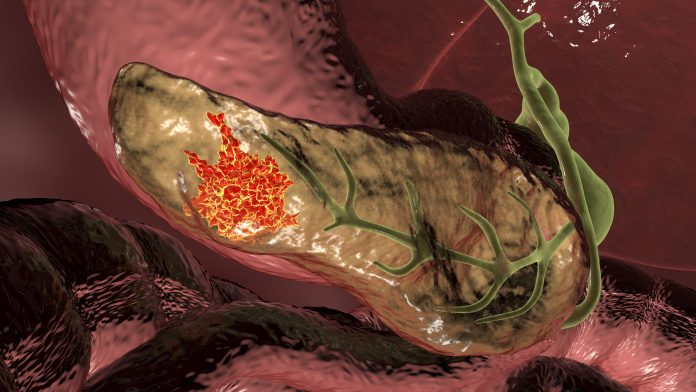
A risk score compiled of known biomarkers can accurately predict early-stage pancreatic cancer and could help reduce the need for biopsies without missing these patients, according to research led by Amsterdam University Medical Centers.
As reported in JAMA Network Open, the researchers compared adult patients with early pancreatic cancer or benign periampullary disease and found their risk score accurately differentiated between the two diseases.
Pancreatic cancer accounts for around three percent of all cancers in the U.S. and around seven percent of cancer deaths. It has a poor prognosis compared with other cancers, mostly because it is often diagnosed too late for treatment to be very effective, which makes early diagnosis critically important to give patients the best chance of survival.
“A combination of clinical symptoms, carbohydrate antigen 19-9 (CA19-9) serum levels, radiological findings, and pathologic confirmation of the diagnosis by fine-needle aspiration or brush cytology are the current modalities used for diagnosing pancreatic ductal adenocarcinoma (PDAC),” write the authors.
“This diagnostic process is time consuming and the diagnosis often remains inconclusive until after an invasive biopsy or resection of the pancreatic tumor has been performed. Therefore, it would be desirable to investigate a more efficient, accurate, and minimally invasive method for diagnosing PDAC, one that reduces time to treatment and prevents unnecessary diagnostic measures.”
In this study, Elisa Giovannetti, a professor and principal investigator at Amsterdam UMC, and colleagues tested a biomarker score comprised of CA19-9 and bilirubin levels in 545 patients with early pancreatic cancer or benign periampullary disease to assess how well it could predict the presence of cancer. An advantage of these biomarkers is that tests are already easily available for them.
“Elevated levels of CA19-9 are associated with PDAC or distal cholangiocarcinoma and may also be found in benign gastrointestinal disorders often characterized by obstructive jaundice…Levels of bilirubin can be elevated when there is an obstruction of the biliary tree, either due to a benign disorder or a malignant neoplasm. In the case of malignant disease, bilirubin is known to reach higher levels,” explain Giovannetti and team.
“Literature suggests that the biliary tract functions as an excretion pathway for CA19-9 to the liver… Adjusting CA19-9 to bilirubin could improve the diagnostic value of CA19-9 for distinguishing between benign and malignant hepatopancreaticobiliary diseases.”
Overall, 249 patients were in the development cohort and 296 patients in the validation cohort for the score. Using the area under the curve statistical measure, the predictive score achieved a result of 0.89, suggesting it was highly predictive for pancreatic cancer versus benign disease.
The researchers calculated that if the prediction model was used more widely it could reduce the biopsy procedure rate by 6 percent, without missing early-stage pancreatic cancer in any patients.
These results are promising, but need to be tested more widely before such a score could be implemented in the clinic. Other biomarkers could be incorporated into the score and it needs to be tested in patients with suspected, rather than known, pancreatic cancer.













